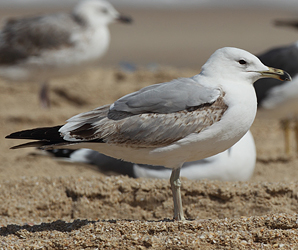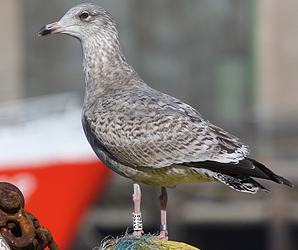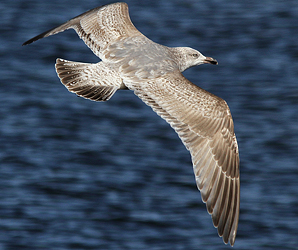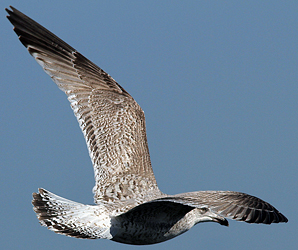 Larus cachinnans
Larus cachinnans
(last update:
Greg Neubauer
Marcin Przymencki
Albert de Jong
Mars Muusse
In 2010, Chris Gibbins, Brian J. Small and John Sweeney published two extensive papers in Britsih Birds, dealing with Caspian Gull. Below, you will find the content of the first paper "Part 1: typical birds".
Part 1: INTRODUCTION & IDENTIFICATION
Part 2: JUVENILES (1CY birds in July–September)
Part 3: BIRDS IN THEIR FIRST WINTER (1CY/2CY birds in October–April)
Part 4: BIRDS IN THEIR FIRST SUMMER (2CY birds in May-September)
Below, we continue with PART 5 Birds in their second winter (2CY/3CY birds during October-April). "we" in the text below refers to the original authors. If any errors occur in this text, please let me know and mail to marsmuusseatgmaildotcom.
Birds in their second winter (2CY/3CY birds during October–April)
The moult to second-winter plumage is usually complete by late November (some complete in October), at which point all feathers are at least second generation. This moult started in spring/early summer and continued through the summer and autumn. Importantly, some of the new feathers gained early in this period are not retained throughout the second winter. Scapulars, some wing-coverts (most frequently the medians) and some tertials may be moulted again later in the period; these third-generation feathers are grey and adult-like and contrast with the remaining brown or barred second-generation ones. Essentially, this is why late summer 2CYs look rather different from December ones, even though in terms of our standard terminology they are in the same plumage/age class. The proportion of adult-type grey feathering is highly variable at this age, but the proportion is typicallygreater than in Herring Gull (many of which are essentially brown in second-winter plumage) and so cachinnans generally look cleaner, older and more striking (plate 70).
The head and body are normally pure white, except for a well-defined collar of dark streaking around the hindneck on some. The mantle and scapulars may be entirely grey, forming a grey saddle, but more typically some feathers retain dark shaft streaks and a paler, creamy fringe. The remaining second-generation lesser and median coverts are basically brownish with creamy or buffish fringes, but dark shaft streaks and small, dark subterminal anchor marks may be apparent in close views. At a distance the greater coverts look rather uniform brown, forming a dark panel; close views reveal a variable amount of pale vermiculation, which typically becomes more prominent towards the inner feathers. A typical cachinnans has some grey, third-generation median coverts (matching the scapulars) and some also have one or two grey tertials which contrast with the largely brown second-generation ones. Some inner greater coverts may also be grey, contrasting with the brown outer ones.
These feather patterns give cachinnans an overall impression that is typically quite different from Herring Gulls of this age. Most Herrings have many brown, heavily anchor-marked feathers in the mantle, scapulars and wing-coverts and extensive streaking or blotching on the head and body (plate 72). Nonetheless, some do have grey feathers in the scapulars (plate 73) and, less frequently, in the wing-coverts, so this difference is not diagnostic. Herring Gull tertials are normally barred and only rarely show the plain brown pattern typical of cachinnans. Second-winter michahellis (plates 74 & 75) share the relatively advanced appearance of cachinnans, but their legs and bill are typically much brighter (often with strong yellow tones evident) and their wings have much stronger, spotted and notched patterns. They also regularly have fine, sharp pencil streaking on the head, especially around the eye, and on the neck.
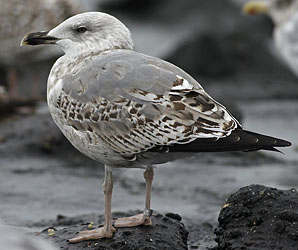 Larus michahellis 2cy CH3160 November 05 2010, Westkapelle, the Netherlands. Picture: Pim Wolf. Ringed as pullus in 2009 in Italy. Compared with cachinnans of this age, note the solid structure, dark streaking around the eye and foreneck, and especially the heavily marked greater coverts. As with cachinnans, the advanced plumage of 2W michahellis (clean head and body, pure grey saddle and many wing-coverts) makes them look older than Herring Gulls of the same age. |
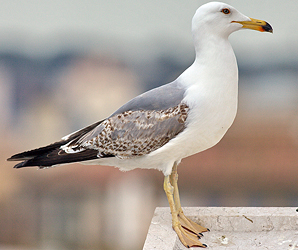 Larus michahellis 3cy, March 26 2012, Rome, Italy. Picture: Hart Walter. By early spring, 3CY Yellow-legged Gulls become extremely clean and bright; compared with the cachinnans in plates 70 & 71, note the bright yellow bill / yellow-toned legs and the strongly notched coverts. The eye is clearly rather pale. |
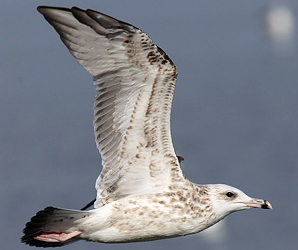 Larus cachinnans 2cy, September 10 2009, Preila, Lithuania. Picture: Chris Gibbins. Note the white underwing, with just a few isolated light brown spots and crescents, and the small mirror on P10. This bird is just completing its moult into 2W plumage, with P9 and P10 not quite fully grown. |
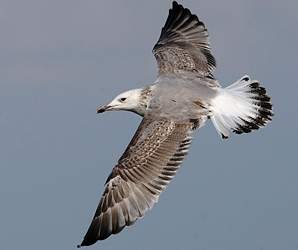 Larus cachinnans 2cy, September 10 2009, Preila, Lithuania. Picture: Chris Gibbins. Note the contrasting black and white tail, Venetian blind pattern on the middle primaries (clearer on the far wing), grey saddle and clean head. |
The underwing of second-winter cachinnans (plate 76) can be gleaming white, but some retain isolated light brown blotches or broken bars over the off-white ground colour. The axillaries tend to be unmarked, pure white. Second-winter michahellis most frequently have contrasting light and dark brown bands on their underwing-coverts, so the underwing looks much darker overall than that of cachinnans; darker birds resemble graellsii Lesser Black-backed Gull. In flight, the general impression of the cachinnans upperwing is very similar to that of first-winters, with blackish-brown outer primaries, secondaries and primary coverts. The pattern on the second-generation inner primaries is extremely variable, but at least some have a strong Venetian-blind pattern – pale, greyish inner webs on the inner primaries that contrast markedly with blackish outer webs. This contrast is much less marked on most Herring Gulls. On some cachinnans the inner-primary pattern is less distinctive, with light brown rather than grey inner webs; such birds are similar to Herring Gulls. Some cachinnans have a diffuse pale lozenge on the outer web of the inner 4–5 primaries (as for first-generation feathers), but on others the distal part of these feathers is a rather uniform brown.
The rump and tail pattern of cachinnans is
rather variable at this age (plate 77) but typically
the pattern is distinctly different from
Herring Gull's. In the most striking cachinnans,
the rump, uppertail-coverts and tail
base are unmarked, pure white and contrast
markedly with a narrow black tail band. Most
frequently, the tail band has fine black vermiculation
along its basal edge. In others, the
rump and uppertail-coverts have some isolated
spots and bars and the tail band is more
coarsely and extensively vermiculated. In
Herring (plate 78), the rump and tail base
are, on average, more spotted and barred and
the tail band is browner, deeper and less
sharply defined, so the general appearance is
much less clean and striking than in cachinnans.
A bird whose tail/rump pattern does
not differ markedly from Herring Gull'
should be checked for other anomalous features
(see part 2).
Most second-winter cachinnans have a
small but distinct mirror on the outer
primary (P10). On some it is small and
sandy-grey, on others it is large and whitish,
but is generally clearly visible. This feature is
extremely useful for separating Herring and Caspian Gulls, although not wholly diagnostic:
a small proportion (c.1–5%) of
second-winter Herring Gulls, particularly
argentatus, have a P10 mirror, while a small
proportion of cachinnans lack a P10 mirror.
It is extremely rare for second-winter michahellis
to have a mirror on P10 (the authors
have seen only one such individual); when
present it is very small and usually apparent
only in good quality photographs.
Bare parts
The bare parts of second-winter cachinnans begin to take on some distinctive hues. The legs are invariably a rather sickly grey ('dead flesh'), compared with the distinctly pink legs of Herring Gulls. The legs of second-winter michahellis are extremely variable: yellowish, greeny-yellow, flesh or grey-flesh.
The basal two-thirds of the bill usually
becomes much paler than on first-summers,
ranging from greyish-pink on some cachinnans to dull greeny-yellow on others. Typically,
there is a dark smudge near the tip that
extends back along the cutting edge towards
the base. The pale bill tip is usually much
more prominent than on first-winters.
However, while cachinnans typically have this
bill pattern, the colours and patterns of all
taxa vary markedly: there is much overlap
and it is not hard to find Herring Gulls and
michahellis that match cachinnans.
The eye is almost invariably dark-looking in second-winter cachinnans, contrasting sharply with the white head. Most Herring Gulls and michahellis begin to develop paler irides at this age (greyish or brown) and so a bird with distinctly pale eyes is unlikely to be cachinnans.
END OF PART 5
CONTINUE AT PART 6: OLDER IMMATURE PLUMAGES (3CY-5cy BIRDS)
 Larus cachinnans 1CY-2CY UKK T-002092 December 2006 & October 2007, Deponie Pohlsche Heide, Germany (52°23'05N, 08°46'45E).
Picture: Armin Deutsch.
Larus cachinnans 1CY-2CY UKK T-002092 December 2006 & October 2007, Deponie Pohlsche Heide, Germany (52°23'05N, 08°46'45E).
Picture: Armin Deutsch.  Larus cachinnans 1CY & 2CY PUBN September 2010 & October 2011, Poland. Picture: Michal Rycak & Artur Niemczyk.
Larus cachinnans 1CY & 2CY PUBN September 2010 & October 2011, Poland. Picture: Michal Rycak & Artur Niemczyk. Larus cachinnans? 1CY & 2CY PVPS June 2011 & October 30 2012, Russia & Bahrain. Picture: Larisa Plusnina & Howard King.
Larus cachinnans? 1CY & 2CY PVPS June 2011 & October 30 2012, Russia & Bahrain. Picture: Larisa Plusnina & Howard King. From: Selitba Lake, Penza oblast, Russia, central point of the lake: 53°10'11.04"N, 46°50'9.84"E.
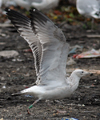 Larus cachinnans 2CY 211P October 22 2008, Deponie Pohlsche Heide - Minden, Germany (52°23'05N, 08°46'45E).
Picture: Armin Deutsch.
Larus cachinnans 2CY 211P October 22 2008, Deponie Pohlsche Heide - Minden, Germany (52°23'05N, 08°46'45E).
Picture: Armin Deutsch.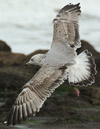 Larus cachinnans 2CY 260P October 21-29 2008, Westkapelle, the Netherlands. Picture: Ies Meulmeester & Walther Leers.
Larus cachinnans 2CY 260P October 21-29 2008, Westkapelle, the Netherlands. Picture: Ies Meulmeester & Walther Leers. Larus cachinnans 2CY 365P October 22 2009, Deponie Pohlsche Heide - Minden, Germany (52°23'05N, 08°46'45E).
Picture: Armin Deutsch.
Larus cachinnans 2CY 365P October 22 2009, Deponie Pohlsche Heide - Minden, Germany (52°23'05N, 08°46'45E).
Picture: Armin Deutsch. Larus cachinnans 2CY P553 October 29 2013, Visé, Belgium. Picture: Walther Leers.
Larus cachinnans 2CY P553 October 29 2013, Visé, Belgium. Picture: Walther Leers. Larus cachinnans 2CY PHSP October 04 2012, Westkapelle, the Netherlands. Picture: Maarten van Kleinwee.
Larus cachinnans 2CY PHSP October 04 2012, Westkapelle, the Netherlands. Picture: Maarten van Kleinwee.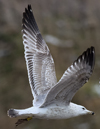 Larus cachinnans 2CY-3CY PKBB October 2012 & February 2013, Germany & the Netherlands. Picture: Armin Deutsch & Maarten van Kleinwee.
Larus cachinnans 2CY-3CY PKBB October 2012 & February 2013, Germany & the Netherlands. Picture: Armin Deutsch & Maarten van Kleinwee. Larus cachinnans 1CY-2CY PLVE December 2012 - February 2014, Utrecht & Amsterdam, Noordzee, Terschelling, the Netherlands.
Larus cachinnans 1CY-2CY PLVE December 2012 - February 2014, Utrecht & Amsterdam, Noordzee, Terschelling, the Netherlands.  Larus cachinnans 2CY PNKA September-October 2014, France-Belgium.
Picture: Laurent Houssier & Peter Adriaens.
Larus cachinnans 2CY PNKA September-October 2014, France-Belgium.
Picture: Laurent Houssier & Peter Adriaens.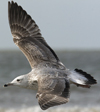 Larus cachinnans 2cy PLG DN-24974 February & October 2009, Germany & the Netherlands. Picture: Armin Deutsch, Ruud Altenburg & Mars Muusse.
Larus cachinnans 2cy PLG DN-24974 February & October 2009, Germany & the Netherlands. Picture: Armin Deutsch, Ruud Altenburg & Mars Muusse. Larus cachinnans 1CY-2CY PLG DN-25866 2008 & 2009, Deponie Pohlsche Heide - Minden, Germany (52°23'05N, 08°46'45E).
Picture: Armin Deutsch.
Larus cachinnans 1CY-2CY PLG DN-25866 2008 & 2009, Deponie Pohlsche Heide - Minden, Germany (52°23'05N, 08°46'45E).
Picture: Armin Deutsch. Larus cachinnans hybrid? 2cy-3cy PLG DN-25884 October 2009 & September 2010, Westkapelle, the Netherlands. Picture: Theo Muusse.
Larus cachinnans hybrid? 2cy-3cy PLG DN-25884 October 2009 & September 2010, Westkapelle, the Netherlands. Picture: Theo Muusse..jpg) Larus cachinnans 2CY 008:U October 26 2014, Castricum, the Netherlands. Picture: Ruud Altenburg.
Larus cachinnans 2CY 008:U October 26 2014, Castricum, the Netherlands. Picture: Ruud Altenburg.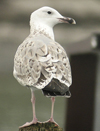 Larus cachinnans 2CY, October 21 2006, Bøgeskoven Havn, Denmark. Picture: Lars Adler Krogh.
Larus cachinnans 2CY, October 21 2006, Bøgeskoven Havn, Denmark. Picture: Lars Adler Krogh. 

